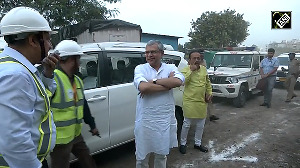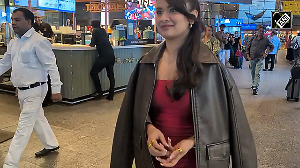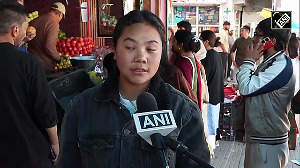The Federation of Kerala Associations of North America (FOKANA) is one of the largest desi organisations and the South Asian Journalists Association (SAJA) is one of the most effective on account of its impact on mainstream journalism in the United States.
The individual contributions of its members and its collective effort to change the image of the desis have come to be recognised. The SAJA stylebook is an indispensable instrument in the editorial rooms of the New York Times and the Washington Post when they have to figure out the distinctions between bindi and bidi and Hindi and Hindu.
I was witness to the birth of the two organisations, the first in 1983 and the second, ten years later. The two have different mandates and aspirations, but both serve the cause of India in the United States, though the word, 'India' does not appear in their names.
In fact, India dominates the discussions in both, though FOKANA represents only a section of the Indians and SAJA embraces a few more countries in the region. The conventions of FOKANA in Orlando and SAJA in New York, within a period of two weeks in July 2006, presented different styles and motivations, but had the common strand of loyalty to their origins of their members.
FOKANA has a lot of grey hair, bulging midriffs and formal attire; SAJA is all about youth, smart casuals and ethnic chic. There is a sprinkling of youth in FOKANA too, but it has no time for the long meetings on art, literature and politics of Kerala and the nostalgic parade of the diversity of 'God's Own Country.'
The youngsters have their own sports, dating cruises and late night discos while the elders bask in the glory of their homeland, brought to the American shores by politicians, film stars, journalists and retired ambassadors.
SAJA is more a networking dynamo right across the generation gap. Some of the grey members looked not only as fashionable as their spaghetti-thin younger colleagues, but also as keen to learn and to instruct. The sessions were vibrant in both, but in FOKANA the focus was on a heady cocktail of nostalgia, pride, money and anxiety about the future, while in SAJA it was on professionalism, career advancement, relevance to the American milieu, the image of South Asia and confidence about the future.
The guest lists of the two organisations told their own tales. FOKANA attracted two central ministers of Kerala origin, a matinee idol from Malayalam cinema, a celebrated film director, two journalists, a bureaucrat and a police officer, both with literary accomplishments.
The only white American seen at the 'Changampuzha Nagar', named after Kerala's most famous romantic poet of the last century, was a candidate for governor of Florida, who came in the hope of getting a few Indian votes.
SAJA had Brian Williams, the anchor of the NBC Nightly News, Richard Boucher of the State Department, Riz Khan of Al Jazeera International, Betty Wong of the Reuters, USA and dozens of stars from the journalistic firmament of the US, together with the big names among SAJA's own members. There was much to learn from each session, whether it was a workshop on journalism skills or on the South Asian economy. The participants had as much to say as the instructors and some instructors like me learnt much from young 'SAJAers.' The future was the theme, not nostalgia or regret over the past.
Comfort, convenience, pomp and entertainment were the watch words in FOKANA. The Federation hired an entire resort in Orlando, which was inside a three acre cocoon of air conditioned comfort. Its exclusive cuisine did not permit the introduction of Kerala delicacies, much to the chagrin of the purists, who could not do without spicy fish and cassava. They were found picking up packets of Kerala food from the parking lot and smuggling them into the resort. The fire alarm went on at least once when someone tried to do some frying of fish in a suite.
The venue of the SAJA Convention was the hallowed campus of Columbia University, with just the basic comforts and no luxuries. At the opening reception hosted by Reuters, the guests were keener to talk than to savour the goodies. Rural South Asia came alive on one day when a Sri Lankan dosa cart and a Pakistani halal chicken cart were wheeled into the Columbia campus. Even there, the enthusiasm was more for networking than for the desi diet.
FOKANA had its own unique features this year. For the first time, it brought in experts on franchises to the convention to assist those interested in opening small businesses. For the more affluent, there was a session on economic development in Kerala, where the Minister for Oversees Indians Vayalar Ravi, gave a glimpse of the investment opportunities in India today.
The political awareness session was rather brief. But these features demonstrated the coming of age of the Indian Diaspora in the United States. They have begun to look for opportunities in the United States as well as in India so that they can literally have the best of both worlds.
Minister of State for External Affairs E Ahamed, (I could not help remarking that the 'e' at the beginning of his name was a hallmark of modernity) gave them the good news that the dual citizenship was already available for American citizens of Indian origin.
Keralites have also begun to cultivate mainstream political leaders, though FOKANA does not do much in this field, compared to other organisations. A Malayalee doctor, who has close connections with the Republican Party, gave them clues about building political bridges not only with Kerala but also with the country of their adoption.
Ceremonies and rituals kept the FOKANA and the SAJA conventions far apart. The arrival of every important guest called for an inaugural ceremony with lighting of lamps, even if the guest himself shied away from what he considered a Hindu ritual in a secular country. An Islamic equivalent of the lighting of the lamp is yet to be invented in Kerala.
SAJA had no rituals, not even an inaugural one. Unending speeches without focus was another feature of the FOKANA convention the 'SAJAers' avoided. Those who spoke at SAJA made a contribution to the knowledge bank of the organisation and did so with considerable zest and humour. The eagerness and attention of the audience kept the speakers on track and, during the Q&A sessions, on their toes.
The generation gap was evident even in the quest for positions. FOKANA was preoccupied with the elections of the next group of leaders to guide it for the next two years. Florida lived up to its reputation for elections and cast a spell on FOKANA as the results announced by the Election Commission were disavowed by a majority in the Commission
At SAJA, I never heard of elections, even if they were held at all. A set of leaders went about their work regardless of their titles.
The first generation of desis is still struggling for an identity, while the next has embraced its present and moves on. For the former, their Indianness is an anchor, which restrains it, while for the latter, it is a legacy that inspires them to soar high. Both are genuinely desi and both do South Asia proud.
I was amused that I was more of a former ambassador at FOKANA, while I was more of a Rediff columnist and a television anchor at SAJA. Focusing on the future makes every one feel young.





